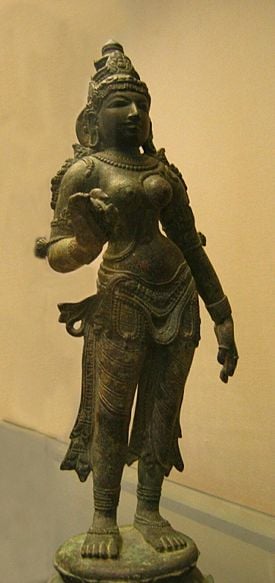Bhudevi
| ||||||||||
Bhuma Devi or Bhumi Devi or Bhu Devi is an earth goddess and the divine wife of Varaha, an Avatar of Vishnu. Bhudevi is the Goddess of Earth, and the fertility form of Lakshmi. Prithvi is also called Dhra, Dharti, Dhrithri, meaning thereby, which holds everything. As Prithvi Devi, she is one of two wives of Lord Vishnu. His other wife is Lakshmi. Prithvi is another form of Lakshmi. Another name for Her is Bhumi or Bhudevi or Bhuma Devi. Bhudevi or related goddesses personifying the earth often accompany incarnations of Vishnu, and as such it is often the earth's call for help which triggers the descent of the sky god [1]
Mythology
Vedas
Prithvi (Sanskrit: pṛthvī, also pṛthivī) is the Hindu earth and mother goddess found in the Vedas. She is the personification of the Earth, taking on the attributes of a loving mother.
She shares many common traits with other earth goddesses such as the Greek Gaia, in that she is personified as a mother and paired with a sky god as her consort.
As prithvi mata "Mother Earth" she contrasts with Dyaus pita "father sky". In the Rigveda, Earth and Sky are frequently addressed in the dual, probably indicating the idea of two complementary half-shells.
She is the wife of Dyaus Pita ('father Dyaus'). (The widespread belief that these two were originally a single deity appears to be mistaken. See Dyavaprthivi). She is the mother of Indra and Agni. According to a tradition, when Indra killed Dyaus Pita, she applauded and married him. She is associated with the cow. Prithu, an incarnation of Vishnu, milked her in the cow's form to get food from her.
According to Hindu mythology, the divine saint Andal is a form of her.
The demon Narakasura whose killing by Krishna is celebrated as the festival of Diwali is her son.[2].
Bhumi Devi is also believed to be one of the two forms of Lakshmi. The other is Sridevi, who remains with Narayana.
Epics
In the Valmiki Ramayana, Rama's wife Sita is discovered in a plowed field by Janaka, king of Mithila. Hence, Sita is born ayonija — not from the womb of a woman but rather from the womb of the earth itself, and for that reason she has been regarded as a daughter of Bhudevi. Throughout the story, however, she becomes something of an earth goddess and therefore a representation of Bhudevi in her own right; after all, she is the incarnation of Sri-Lakshmi, who herself has been related to the bounty of the earth and Bhudevi. Sita, then, in the tradition of Bhudevi, inherits this mytheme of the fertile, feminine earth , which is fructified by the decidedly male power of the sky incarnate in the person of the titular hero.
In the Uttara-Kanda, the final book of the Ramayana, Rama banishes Sita to the forest due to unsubstantiated public suspicions that she may have compromised her chastity under captivity of the demon Ravana. Rama insists upon having Sita go through with the exile in spite of the fact that she has already survived the Agni pariksha — the harrowing task of walking through fire — in order to prove her chastity to him. Later on Rama realizes the error of his ways and eventually seeks out Sita in the forest, begging for her return to Ayodhya. At this point Sita requests that Bhudevi take her back, and she is promptly swallowed into a cleft in the soil, never to be seen again. Not only does this deus ex machina provides Sita with some measure of justice in the face of intense suffering, but it also reaffirm her status as daughter and incarnation of the earth mother.
Puranas
According to the Puranas, Bhudevi is the consort of Varaha, Vishnu's third avatar. In the story of their pairing, Bhudevi takes on the role of the earth in its most literal, elemental form, while Varaha takes the form of a boar. When mother earth is carried off by asuras and submerged under the vast ocean by the orders of the demon Hiranyaksha, Varaha comes to her aid, diving deep down into the great waters. Here he kills Hiranyaksha and steadies Bhudevi on his snout, carrying her above the water once again. He then maps the geography of the land as we know it today, sculpting mountains and valleys, and dividing it into seven continents.
Iconography
In art she is represented as a woman with four arms and a green skin. One of the most common depictions of Bhudevi depicts her being carried atop the nose of Varaha; she is relatively small compared to the boar-god.
Notes
- ↑ Nagaran, 168.
- ↑ killing of Narakasura.
ReferencesISBN links support NWE through referral fees
- Dallapiccola, Anna. Dictionary of Hindu Lore and Legend. London: Thames and Hudson, 2002. ISBN 0-500-51088-1
- Kinsley, David. Hindu Goddesses: Vision of the Divine Feminine in the Hindu Religious Traditions. Berkeley: University of California Press, 1988. ISBN 978-0520063396
- Nagaran, Vijaya Rettakudi. "Soil as the Goddess Bhudevi in a Tamil Women's Ritual." In Women as Sacred Custodians of the Earth: Women, Spirituality and the Environment. Ed. Alaine Low and Soraya Tremayne. New York: Bergham Books, 2001. 159-174. ISBN 1-57181-467-1
Credits
New World Encyclopedia writers and editors rewrote and completed the Wikipedia article in accordance with New World Encyclopedia standards. This article abides by terms of the Creative Commons CC-by-sa 3.0 License (CC-by-sa), which may be used and disseminated with proper attribution. Credit is due under the terms of this license that can reference both the New World Encyclopedia contributors and the selfless volunteer contributors of the Wikimedia Foundation. To cite this article click here for a list of acceptable citing formats.The history of earlier contributions by wikipedians is accessible to researchers here:
The history of this article since it was imported to New World Encyclopedia:
Note: Some restrictions may apply to use of individual images which are separately licensed.

